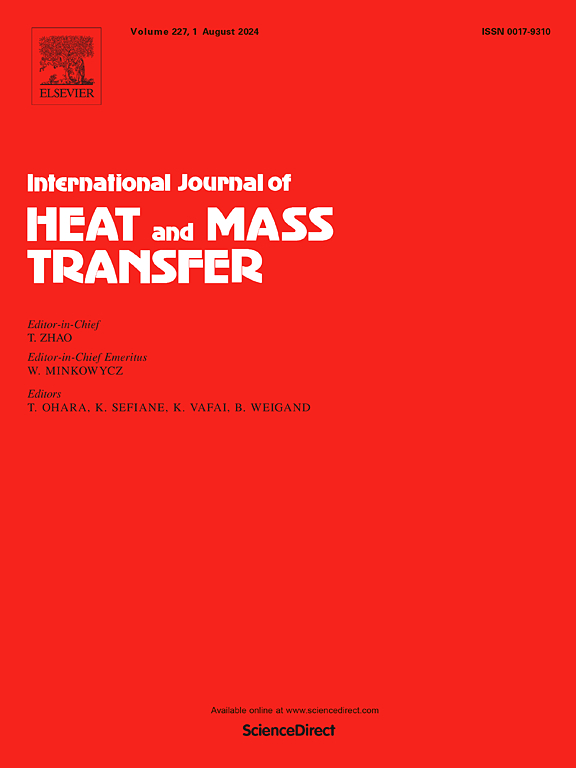基于Q-SORA策略的pemfc湍流冷却剂通道可靠性热流结构拓扑优化
IF 5.8
2区 工程技术
Q1 ENGINEERING, MECHANICAL
International Journal of Heat and Mass Transfer
Pub Date : 2025-04-26
DOI:10.1016/j.ijheatmasstransfer.2025.127158
引用次数: 0
摘要
考虑到多孔多热源在双极板上的随机位置,为了在质子交换膜燃料电池(pemfc)的流动耗散和热可靠性水平之间取得理想的平衡,本研究建立了一个基于可靠性的冷却剂通道拓扑优化(RBTO)框架。在RBTO中,受目标结构柔度和热失效概率的影响,最小化通道的流动耗散,并采用基于分位数的顺序优化和可靠性评估(Q-SORA)策略对RBTO框架进行有效解耦,这涉及在当前通道拓扑下的确定性拓扑优化和分位数估计的顺序循环。当目标失效概率(PfT)为3.8%(0.2%)时,均匀热源和梯度热源对应的最小流动耗散分别为0.000729 (0.001844)kg·m2/s3和0.000674 (0.001476)kg·m2/s3。此外,随着PfT的降低,流动耗散显著增加,冷却剂通道与反应多孔气体通道相同的流动方向可以有效降低冷却剂通道RBTO内的流动耗散成本。此外,随机多热源位置对bp最高温度(Tmax)的影响可以随着入口速度的增加而减小。当进口速度大于2m/s, PfT为3.8%时,平均热源位置bp的Tmax和拓扑冷却剂通道的流动耗散均低于传统的直线型多通道配置。本文章由计算机程序翻译,如有差异,请以英文原文为准。
Reliability-based thermal-fluid-structural topology optimization for PEMFCs’ turbulent coolant channels by Q-SORA strategy
In order to attain a desirable trade-off between the flow dissipation and thermal reliability level of proton exchange membrane fuel cells (PEMFCs) when considering the random positions of porous multi-heat sources on bipolar plates (BPs), this work establishes a reliability-based topology optimization (RBTO) framework for coolant channels. In the RBTO, the flow dissipation of the channel is minimized subject to the target structural compliance and thermal failure probability, and the RBTO framework is decoupled by quantile-based sequential optimization and reliability assessment (Q-SORA) strategy efficiently, which involves a sequential loop of deterministic topology optimization and quantile estimation under the current channel topology. When the target failure probability () is set to 3.8 % (0.2 %), the minimized flow dissipation corresponding to uniform and gradient heat sources is 0.000729 (0.001844) kg·m2/s3and 0.000674 (0.001476) kg·m2/s3, respectively. In addition, the flow dissipation increases significantly with the decrease of the , and the same flow directions of coolant channels and the reaction porous gas channels can effectively decrease the flow dissipation cost in RBTO of coolant channels. Moreover, the impacts of random multi-heat source positions on the maximum temperature (Tmax) of the BPs can be reduced with the increase of inlet velocity. When the inlet velocity is higher than 2m/s and the is 3.8 %, Tmax of the BPs at the mean heat-source positions and the flow dissipation of the topological coolant channel are both lower than those of the traditional straight multi-channel configuration.
求助全文
通过发布文献求助,成功后即可免费获取论文全文。
去求助
来源期刊
CiteScore
10.30
自引率
13.50%
发文量
1319
审稿时长
41 days
期刊介绍:
International Journal of Heat and Mass Transfer is the vehicle for the exchange of basic ideas in heat and mass transfer between research workers and engineers throughout the world. It focuses on both analytical and experimental research, with an emphasis on contributions which increase the basic understanding of transfer processes and their application to engineering problems.
Topics include:
-New methods of measuring and/or correlating transport-property data
-Energy engineering
-Environmental applications of heat and/or mass transfer

 求助内容:
求助内容: 应助结果提醒方式:
应助结果提醒方式:


